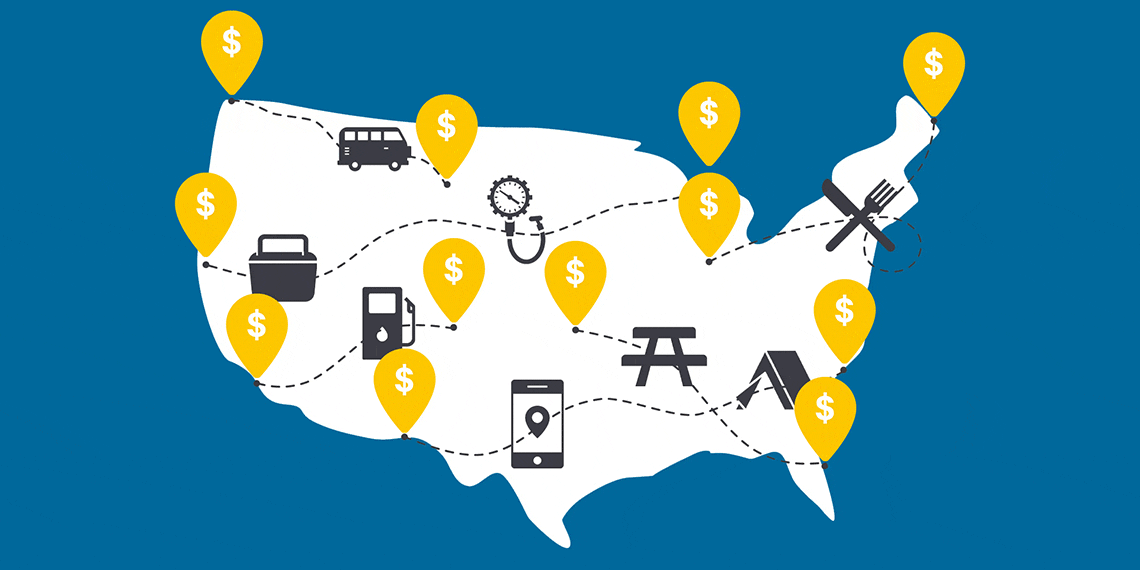
Thinking of hitting the open road this year? You are not the only one. According to one new travel survey, road trips are on the rise in the United States, as more families choose driving over flying for their vacations. Not only can road trips help you skip the security lines at the airport, but with proper budgeting, they can also be great for your wallet.
Remember that the costs of traveling via car can add up fast. You’ll need to gas up every few hundred miles, eat out for every meal and pay for hotels along the way. Then there are the unexpected costs—what if you get a flat tire?
Follow these money-saving tips as you navigate America’s highways this year.
1. Plan (Most of) Your Route
The best road trips often involve spur-of-the-moment excursions. You might come across a roadside attraction or see something on the map 20 miles away you want to check out. So while you might not want to plan every hour and mile of your trip ahead of time, sketching out potential routes can help your budget and your sanity.
Charting a course can help you estimate mileage and gas expenses, which will help you save ahead of leaving the driveway. Not only will you be able to pinpoint budget-friendly restaurants, gas stations and lodging along your route, but having a rough plan will also allow you to spend more time enjoying your trip without the added stress of getting lost along the way.
2. Set Goals for the Trip
There are different types of road trips, so know ahead of time what you want to achieve from this trip. Are you searching for adventure? Are you eating your way across the country? Are you planning to relax poolside at hotels along the way?
To stay on budget, determine what is important for your trip and cut back on expenses elsewhere. If you plan to pay extra for Michelin-starred dinners, consider cutting down on lodging costs by packing the family tent and finding a local campsite along the way. The National Parks Service manages campgrounds in parks across the country, many of which offer showers and other services.
3. Bring Your Own Meals
Dust off the cooler in your basement and put it in the truck of your car before you go. Even if dining in at restaurants is one of your must-haves for the trip, you never know when you might need a midday snack.
Packing grocery staples will help you stay on budget while also saving more time for the things that you enjoy the most. There are many, many smart packing lists for food available online. Tailor your list to what your family or friends like—and don’t forget the snacks.
4. Understand Your Limits
Before you step on the gas, take a moment to think about your limits and the limits of your fellow travelers. You may be able to drive 24/7 or sleep in the cramped back seat, but can everyone on your trip do the same? Ask yourself these questions to start:
- How many hours can I reasonably drive in one day?
- What time do I plan on waking up each morning? What about falling asleep?
- If I decide to camp, will I be comfortable in a tent each night?
- Am I traveling with others? And if so, what are their limits?
Having answers to these questions will make your trip run smoother. You’ll also save yourself from unexpected expenses, such as checking into a hotel when your kid can’t get to sleep at your perfectly good campsite.
5. Be Ready for the Unexpected
Your road trip itinerary likely doesn’t include “flat tire at 10:00 a.m.,” but unexpected costs on a road trip shouldn’t surprise you—or your wallet. You should include a small emergency fund in your travel budget so that you don’t end up with unexpected debt or the inability to pay for something essential.
You might also want to learn the basics of car maintenance because towing and roadside assistance in an unknown place can include hefty price tags. Know where your vehicle’s manuals and maintenance records are and prepare your vehicle ahead of your trip. If you are renting a car, make sure any hiccups will be covered by insurance—either through the rental car agency or your credit card.
6. Befriend the Locals
There is no doubt that a local will know their area better than someone passing through. Make sure to travel safely and don’t get yourself in any uncomfortable situations, of course. Locals—including restaurant staff, hotel concierges or gas station clerks—may be able to point you toward budget-friendly attractions or other hidden gems.
If talking to the locals in person isn’t part of your ideal road trip, there are forums all across the internet where people will gladly recommend options for you.
7. Go Digital
Take a scroll through your app store before your next trip and download some travel-friendly apps. There are apps that can help you connect with travel communities worldwide, there are apps that will help you find the cheapest gas in the area, and there are others that can help you find an inexpensive last-minute place to stay.
Makenna Subbert is a solo traveler who has traveled to 40 U.S. states and over 50 national parks. She is currently completing her bachelor’s degree at the University of Central Florida.

